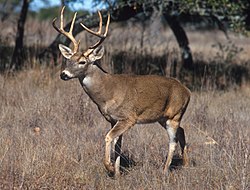| Odocoileus Temporal range: Pleistocene to present | |
|---|---|
 | |
| Odocoileus virginianus | |
| Scientific classification | |
| Kingdom: | Animalia |
| Phylum: | Chordata |
| Class: | Mammalia |
| Order: | Artiodactyla |
| Family: | Cervidae |
| Subfamily: | Capreolinae |
| Tribe: | Odocoileini |
| Genus: | Odocoileus Rafinesque, 1832 [1] |
| Type species | |
| Odocoileus speleus [1] Rafinesque, 1832 | |
| Species | |
Odocoileus hemionus Contents | |
Odocoileus is a genus of medium-sized deer (family Cervidae) containing three species native to the Americas. [1] [3] [4] The name, sometimes spelled odocoeleus, is a contraction of the Greek root odont-, [5] [6] meaning "tooth," and -coelus, New Latin for "hollow".


